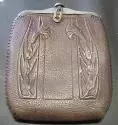Hand-Tooled Leather: The Forgotten Collectible

Not exactly household names, even in an Arts & Crafts bungalow, but they were among scores of firms which produced some of the finest hand-tooled leather articles featuring classic Arts & Crafts motifs: dragonflies, the Macintosh rose, wisteria vines, and iris blossoms.
Many of these firms were influenced by the Roycroft Modeled Leather Department, which evolved in 1905 out of the hand-tooled bookbinding Elbert Hubbard desired for the finest Roycroft publications. Drawing upon the German immigrant population around Buffalo, many of whom were highly-skilled artisans, Hubbard assembled the finest team of designers and craftsmen who created modeled leather desk sets, bookends, wastebaskets, pillows, portfolio covers, purses, and table mats.
While Roycroft leather articles are not the easiest to find, collectors can select from a number of Arts & Crafts firms which produced works of art in leather that were at once beautiful and useful — and remain so today.
Fortunately for us, Daniel Lees, with assistance from his wife Fairie, has researched, photographed and written the definitive book entitled “Artistic Leather of the Arts & Crafts Era” (Schiffer Publishing, 2009). With an extensive forward by renown Roycroft collector Boice Lydell, it provides even the casual collector with a wealth of information about this under-appreciated art form.
Daniel has provided a few tips for us as we begin our search in antique malls, shows, and online for hand-tooled leather purses, desk sets, wallets, and accessories, and recommends that collectors be picky when it comes to condition. Here, then, are things to watch for:
The Lacing – This would be the first to suffer from excessive wear, for the fragile leather lacing, especially along the handle, proved prone to breaking. Accept only a few breaks, so long as sections are not missing. “Walk away,” Daniel writes, “from one with a broken handle.”
The Latch – The ‘Turnloc’ tab mechanism should work easily. If the purse has a hole at the top, the latch is missing. Avoid purses with broken latches, for better examples can be found.
The Frame – Check to make sure the frame closes evenly, and that the metal does not exhibit any excessive wear. Fresh paint is a danger sign.
The Leather – Although leather will eventually dry out, it should remain flexible and not show signs of cracking. Dark, limp items may have been soaked or treated with Neatsfoot oil, which Daniel advises you avoid.
The Interior – The suede or ‘ooze’ leather interior often is home to mold and mildew. Avoid these. Stale odors can be release by letting it air out, but avoid ripped, torn and moldy fabrics.
The Accessories – It is always great to find a purse with its original mirror and change purse, although they were not always signed by the firm. You can usually tell by the color and design if they were taken from another purse and placed in the one you are inspecting.
Arts & Crafts leather remains one of the most affordable collectibles still available, often selling for less than a hundred dollars. Easy to display, they often can still be used — and make great gifts for the Arts & Crafts collector in your family (along with a copy of Daniel’s book, “Artistic Leather of the Arts & Crafts Era”).
Good Luck!
– Bruce

